Imagine stepping into a bustling medieval marketplace, where the vibrant colors of livery distinguish servants from nobility, each hue telling a story of status and duty. Uniforms have morphed from mere symbols of rank to complex expressions of identity across various sectors. You might wonder how these garments evolved into the contemporary styles we see today, reflecting societal changes and professional demands. What role do these seemingly simple outfits play in shaping our perceptions and interactions in today's world? Exploring this can reveal layers of significance you might not have considered.
Early Origins of Uniforms
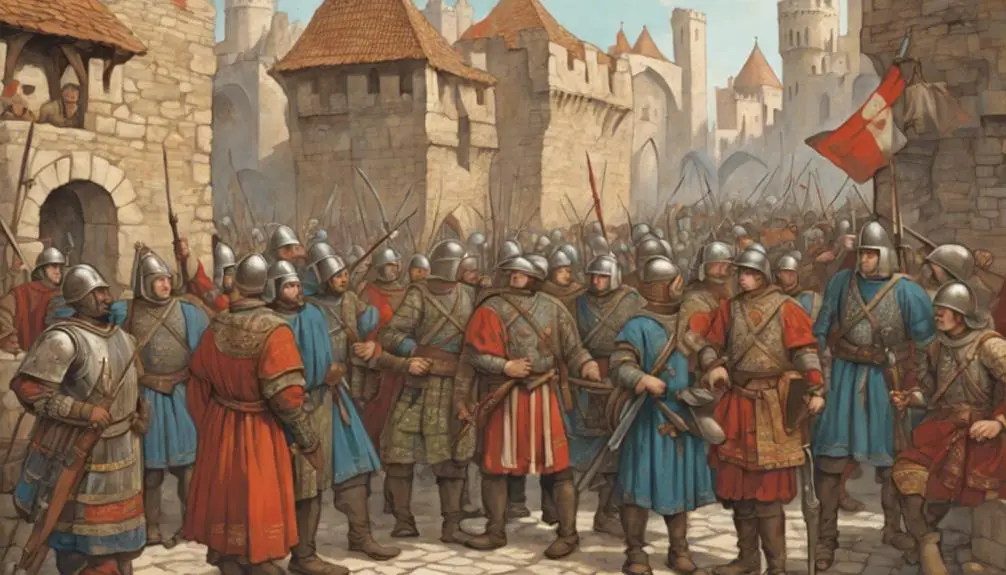
Throughout history, uniforms have played a vital role in establishing identity and unity. The earliest uniforms, known as liveries, can be traced back to the Middle Ages, worn by servants to signify the nobility they served. By the fourteenth century, occupational uniforms began to appear in European courts, showcasing matching garments adorned with employers' coats of arms. This practice symbolized both unity and status, elevating the roles of workers in society.
Simultaneously, military uniforms emerged, using recognizable colors and insignia to help identify rank and authority quickly. The seventeenth century marked a significant evolution, as specific uniform designs for various job roles were introduced. A significant moment came in 1785, when King Frederick II mandated postal worker uniforms, pushing the concept of compulsory attire forward.
The widespread adoption of uniforms for state employees in the nineteenth century emphasized masculine qualities, strategically moving away from the contemporary fashion trends of the time.
This shift not only solidified the importance of uniforms in professional settings but also laid the foundation for the structured attire we see today, reinforcing a sense of belonging and pride among those who wear them.
Military and Occupational Uniforms
Military and occupational uniforms have long served as symbols of authority and professionalism, evolving to reflect the needs of their respective fields. Emerging in the fourteenth century, military uniforms displayed the colors and insignia of royal houses, providing quick identifiers of rank and affiliation.
By the seventeenth century, specific designs for various job roles became prevalent, with King Frederick II of Prussia mandating compulsory attire for postal workers in 1785. This shift emphasized masculine qualities and a move away from fashion trends.
After World War I, many civil uniforms were abolished, viewed as outdated symbols of authority. This led to redesigns that distanced these uniforms from military connotations, such as the introduction of casual police uniforms in Germany, which aimed to foster a more approachable image.
The latter half of the twentieth century saw a further transformation, as organizations embraced corporate wear, focusing on branding and enhancing their organizational identity. Uniforms became essential not just for identification but also for conveying values and professionalism, bridging the gap between traditional military styles and modern workplace attire, creating a unique blend that continues to evolve today.
Evolution of School Uniforms
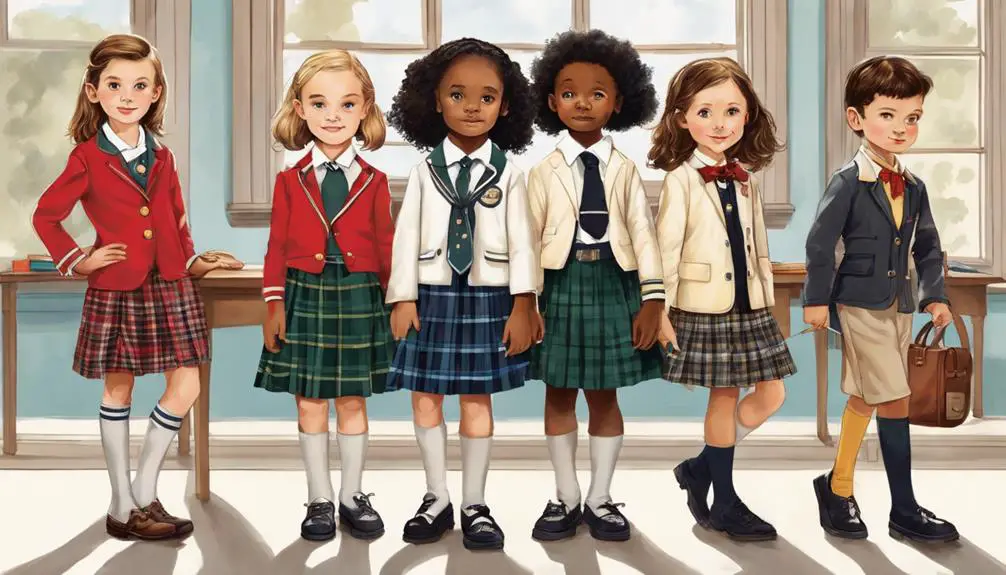
Uniforms have played a significant role in various contexts, including schools, where their evolution reflects changing societal values and educational philosophies. The history of school uniforms traces back to 1222 in England, but modern uniforms took shape at Christ's Hospital in the 16th century with their distinctive blue cloaks and yellow stockings.
By the late 1800s, uniforms became symbols of school pride, especially during the Industrial Revolution when school attendance surged.
In the late 1980s, U.S. public schools began adopting uniform policies to foster unity and ease peer pressure regarding clothing choices. The percentage of schools implementing such policies grew from 12% in 1999-2000 to 21% by 2015-2016, with urban schools, particularly in high-poverty areas, leading the way.
Today, modern uniforms reflect contemporary values, emphasizing accessibility and equity. Schools increasingly embrace gender-neutral options, ensuring that all students feel included and represented.
This ongoing evolution highlights how school uniforms not only serve practical functions but also embody the spirit of community and shared identity, paving the way for a supportive educational environment.
Impact of Social Changes
Social changes have dramatically reshaped the landscape of uniforms across various sectors. After World War I, many civil uniforms were abolished, as they symbolized outdated authority and reflected society's shift toward modern governance and democracy.
Post-World War II, negative perceptions of military-style uniforms led to innovative redesigns, like the casual police uniforms by fashion designer Heinz Oestergaard in Germany, marking a significant departure from traditional aesthetics.
The latter half of the 20th century saw an increased emphasis on corporate uniforms, which enhanced branding efforts and distanced themselves from military influences.
The introduction of the Health and Safety at Work Act in 1974 in the UK marked another substantial social change. This legislation emphasized workplace safety, prompting the integration of personal protective equipment (PPE) into modern uniforms.
More recently, the COVID-19 pandemic has urged organizations to reevaluate uniform policies, highlighting the necessity for functional attire that prioritizes health and safety.
The transformation of uniforms reflects broader societal values, with each change representing a response to the evolving expectations of safety, professionalism, and identity in the workplace.
Modern Trends in Uniform Design
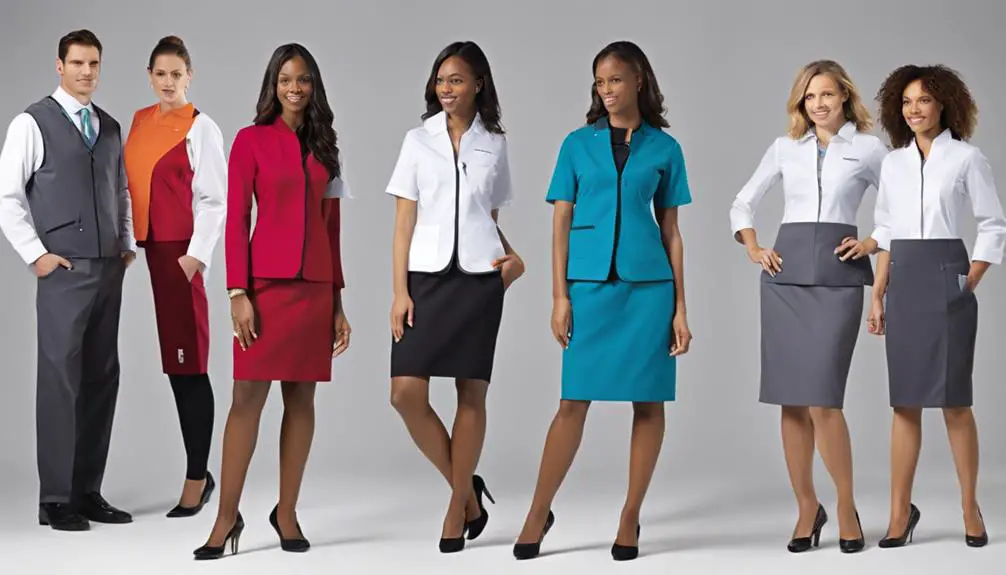
As workplaces evolve, so do the designs of the attire worn by employees. In the twenty-first century, uniform design prioritizes comfort and functionality, moving away from traditional styles to better align with modern work environments.
You'll find that employee input is increasingly valued, enhancing engagement and promoting inclusivity through gender-neutral and customizable options. This approach not only helps employees feel more comfortable but also fosters a sense of belonging.
Full-time designers are now focused on creating innovative styles that meet industry demands and safety standards, particularly in light of the COVID-19 pandemic. The shift towards functional and protective uniforms has led to a greater emphasis on personal protective equipment (PPE) while re-evaluating uniform policies.
Additionally, sustainability is becoming a core principle in uniform design. Trends indicate a growing commitment to environmentally friendly practices, with made-to-order approaches reducing waste and promoting eco-conscious materials.
As you can see, modern uniform design isn't just about looking good; it's about creating attire that reflects the values and needs of today's workforce, balancing style, functionality, and sustainability seamlessly.
Psychological Effects of Uniforms
When individuals don uniforms, they often experience a profound psychological shift that enhances their sense of belonging and identity within an organization. The act of wearing a uniform fosters a strong community, creating a visual representation of shared goals and values. This collective identity can greatly boost your self-esteem, making you feel more confident and authoritative in your role.
Moreover, uniforms promote solidarity among team members, reinforcing the idea that you're part of something bigger. This shared appearance not only cultivates a sense of pride but also enhances professionalism, which is vital in building trust with clients and consumers. When everyone looks united, it conveys commitment and reliability, essential elements in any successful organization.
As you embrace your uniform, you're not just putting on clothes; you're stepping into a role that embodies your dedication and purpose. This transformation can instill a lasting pride in what you do, reminding you daily of your contributions to the team.
Ultimately, uniforms serve as a powerful tool to unite individuals, enhance confidence, and promote a culture of trust and professionalism.
Sustainability in Uniform Production
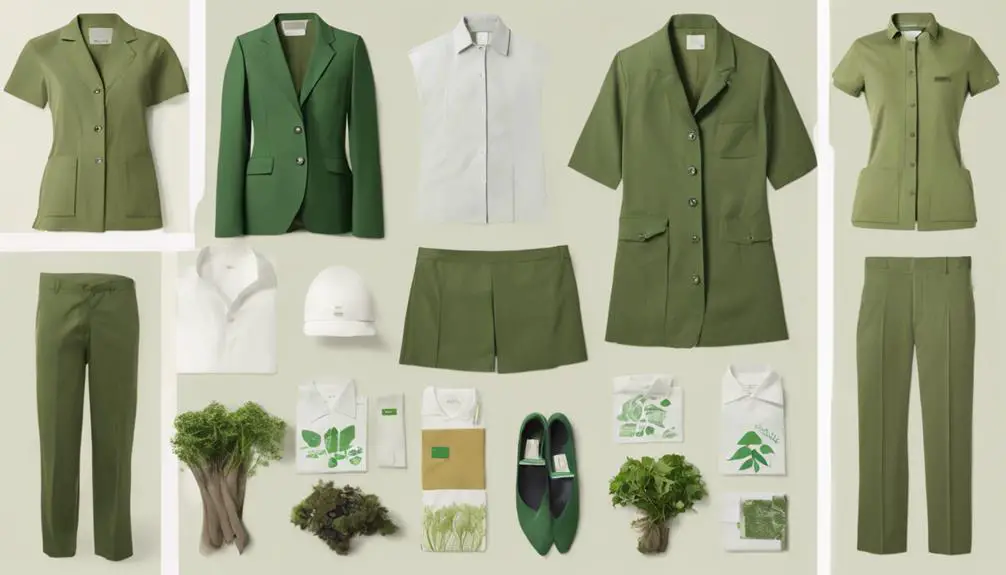
Sustainable practices in uniform production are becoming increasingly essential as organizations recognize the importance of reducing their environmental impact. By adopting sustainable fashion principles, companies are moving towards custom uniforms that minimize waste through a made-to-order approach. This method not only cuts down overproduction but also promotes the use of eco-friendly practices that support the environment.
Bespoke uniforms are designed for long-term use, encouraging environmentally friendly consumption and minimizing the need for frequent replacements. As you consider your uniform options, think about the shift toward smart production methods that utilize sustainable materials. This trend reflects a growing demand for responsibly sourced fabrics, allowing you to reduce carbon footprints in uniform production considerably.
Investing in durable uniforms pays off not just in quality but also in long-term cost savings. By choosing uniforms built to last, organizations can lower their overall expenses, making sustainability an investment in both the environment and the future.
Embracing these practices fosters a culture of responsibility, ensuring that your uniforms reflect a commitment to a greener planet while also serving your team's needs effectively.
Future of Uniforms and Innovation
The future of uniforms is set to revolutionize the way employees interact with their workwear, emphasizing comfort and productivity.
You'll see a shift toward wearer-driven designs that prioritize your feedback, ensuring that uniforms not only look good but feel great too. With advancements in technology, features like smart textiles and integrated safety elements will become standard, making your work environment safer and more efficient.
Sustainable practices will take center stage as the industry embraces made-to-order production methods, greatly reducing waste and promoting environmental responsibility. Innovations in personal protective equipment (PPE) will continue to shape uniform designs, especially as health and safety regulations evolve in various sectors.
Economic considerations will influence the adoption of durable uniforms, allowing businesses to achieve cost savings. By choosing reusable items over disposable alternatives, companies can invest in high-quality apparel that stands the test of time.
The fusion of innovative design, comfort, and sustainability not only enhances your work experience but also supports a healthier planet. As these trends unfold, your uniform will truly reflect the future of work—smart, sustainable, and tailored just for you.
Frequently Asked Questions
Who Invented the Uniform?
You can't pinpoint one inventor of uniforms, as they evolved from military origins to sports attire, reflecting fashion trends and cultural significance. Historical regulations shaped them, showcasing gender differences and impacting branding globally in modern trends.
Why Did People Wear Uniforms?
Did you know that 75% of employees feel more unified in uniforms? People wear them for authority symbolism, workplace discipline, and identity expression, reflecting social conformity and historical significance while adapting to modern trends and cultural variations.
What Are the Facts About School Uniforms?
School uniforms offer benefits like promoting student identity and unity, influencing educational outcomes positively. While parental opinions vary, dress code policies address economic considerations, cultural differences, and fashion trends, impacting the psychological effects on students.
Where Did Work Uniforms Come From?
Did you know that over 60% of workers feel more confident in uniforms? Work attire emerged from the industrial revolution, shaped by labor movements and military influence, reflecting fashion evolution, cultural variations, and modern adaptations of professional identity.
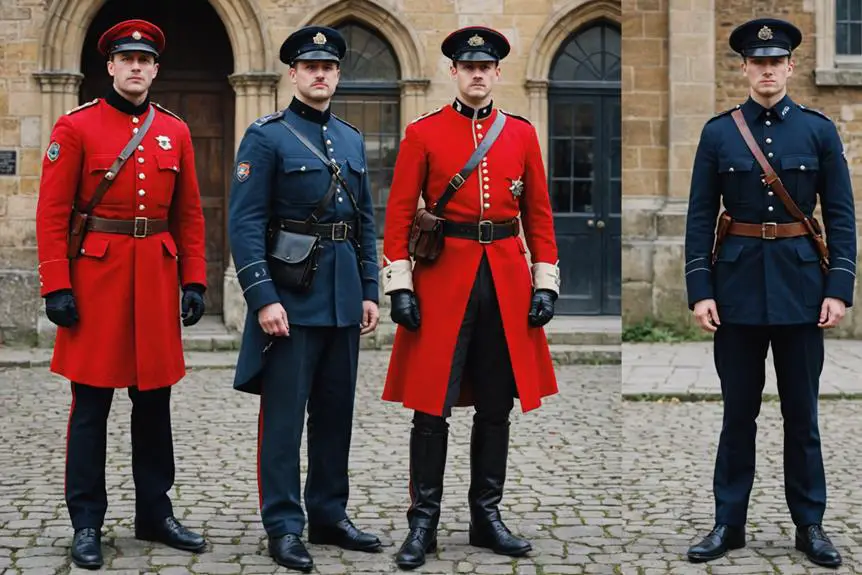

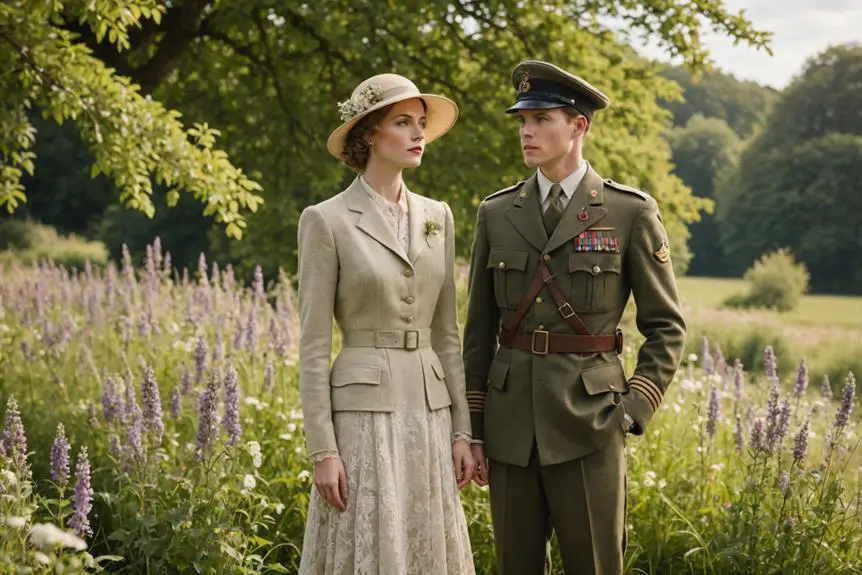
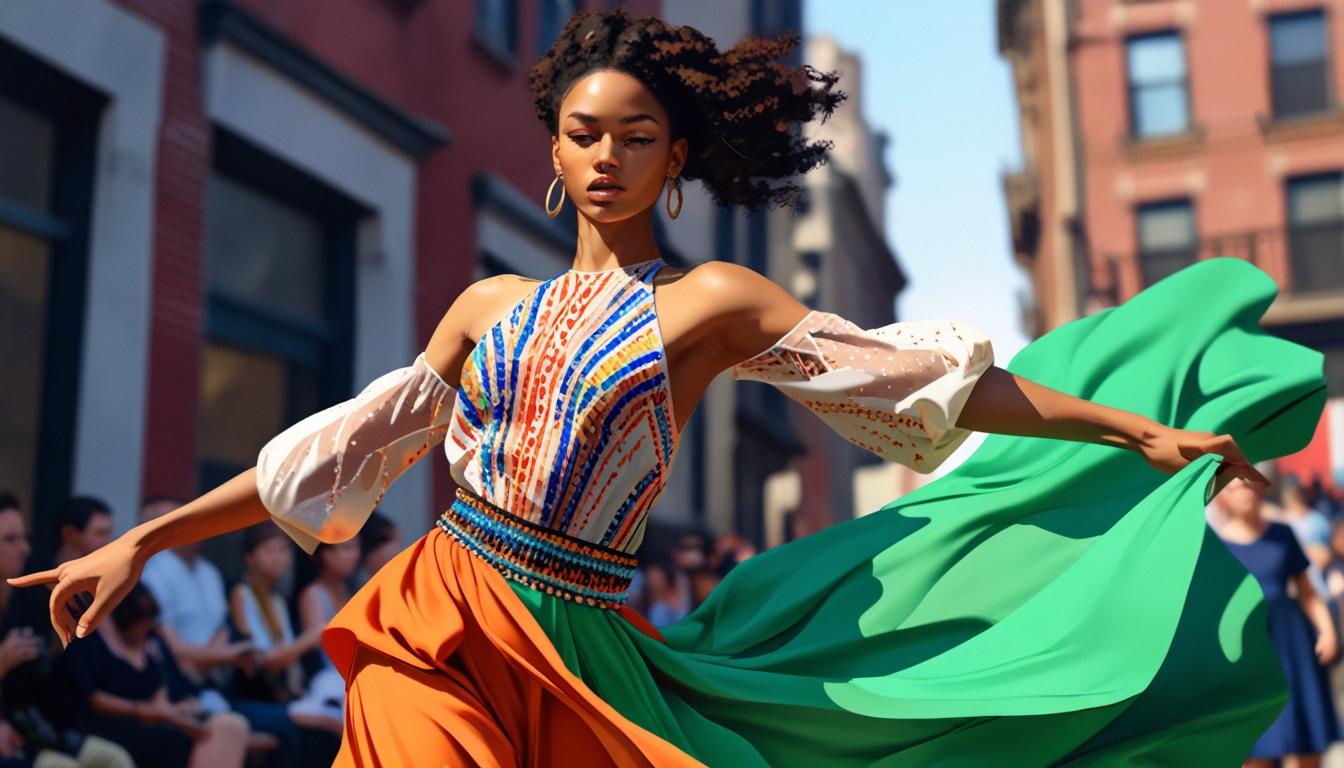
This is the perfect blog fo? anyone ?ho woul? like
to find out ab?ut t?is topic. Yo? understand a w?ole ?ot its almost har? to argue
?ith you (not that I personally ?ould want to…HaHa).
Yo? definite?? put a fresh spin ?n a subject t?at has been ?iscussed f?r
decades. Wonderful stuff, ?ust wonderful!